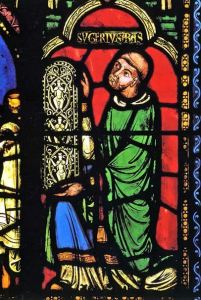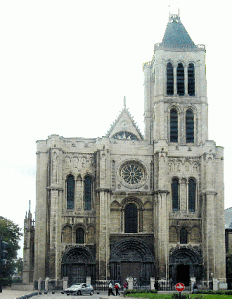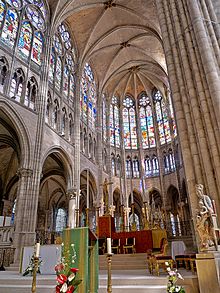According to Genesis 1:3, the Bible tells us that one of God’s very first acts in the Creation process was to bring forth light! The history of Western Civilization is intimately tied to the phenomena of light. Our language is replete with a wide swath of references to human values strongly associated with the word light. Examples such as: illumination, luminescence, brilliance, radiance, understanding, enlightenment, comprehension, knowledge, etc. are words we use on a regular basis where we interconnect light with strong associations of value to the human condition. Combine the symbolic associations we have grown to appreciate regarding the manifestation of light with the more modern understanding that light is not static and you can begin to recognize the importance of light to the Gothic mind.
Abbot Suger, one of the principle contributors to the Gothic movement, made the following observation that was carved into an entranceway to a Gothic interior:
‘All you who seek to honor these doors,
Marvel not at the gold and expense but at the craftsmanship of the work.
The noble work is bright, but, being nobly bright, the work
Should brighten the minds, allowing them to travel through
the lights.
To the true light, where Christ is the true door.
The golden door defines how it is imminent in these things.
The dull mind rises to the truth through material things,
And is resurrected from its former submersion when the
light is seen.’
What are your thoughts/impressions of the Gothic sensibility which Abbot Suger helped fix into visible form through the sense of light?

Abbot Suger in Stained Glass Window of the Abbey of Saint Denis

Facade of the Abbey of Saint Denis

Interior of the Abbey of Saint Denis
I grew up catholic, and as a kid my mom would always take me to church on Sundays. No matter which church we went to the stain glass windows were something I would always see. I would always stare at them for a while, sometimes i would even make made-up stories for the images in the glass. Even though I was just a child, I think I still got a sense of gothic sensibility without even realizing it. I think the idea for Gothic sensibility is not to admire these images exactly for what they are but to let them take you to a new place of thought within the aspects of religion and spirituality. The light on the stained glass makes the images seem surreal. If it were a metaphor one could see the light as god and the stained glass as religion. “God” is being interpreted through religion, evidently this makes your overall time in a place like this a more surreal experience.
LikeLike
Like many contributors, Abbot Suger attempts to impact the Catholic/Christian religious values and had powerful influence catapulting ideas of consciousness and the well-being of an individual. In example, he draws forth the understanding of “light” which encapsulates our ideas on a God, and also the presence of holiness. The entities that are depicted within the churches are symbols of enlightenment, and I think he tries to help us realize how we should acknowledge the narrative and/or existing role models that are emanating within these images, for a well-rounded conceptual and perceptual experience.
LikeLike
As a child I was extremely afraid of the dark. I always needed some form of light on to feel comforted. The existence of light brings me comfort, it makes me feel safe and secure. Many other children to this day also share the same fear that I once had. To this day I still admire the strong sense of emotions that surge inside me while I view beautiful rays of light. I have always wanted to create pieces that represented the beauty of light but never could successfully. Abbot Sugger’s structures are able to capture the light perfectly. I also appreciate that he wants individuals to look past the materialistic features of the doors but to look at the design and feel the light that points towards God.
LikeLike
During the Gothic movement, Abbot Suger transformed the physical religious environment with the use of large, tall stained glass windows – creating a new experience for the faithful, who were bathed in light that seemed to hover above them as they entered the Gothic cathedral. I have visited many Gothic cathedrals throughout Europe and I am always blown away by the difference between the busy city streets and the stone exterior, which is rather drab with the windows looking like they are black, with the feeling of peace and a heavenly aura of colored light as you step from the outside world into the refuge of the interior. I think that human beings have always been naturally drawn to light, Suger was himself enlightened to employ light as a means to help guide us all towards the “true light” of Christ.
LikeLike
Abbot Suger wanted to create a physical representation of Heavenly Bethlehem, and sunlight makes the stain glass is a beautiful colorful. I like the Abbot Suger’s stained glass window. However, I don’t know understand why the monk man is holding a image of naked women. I think if he held the bible or a crucifix, it would be a better fit.
LikeLike
i have an appreciation for these style buildings and the stained glass inside. when i was in Germany I would go into the local cathedrals to appreciate the craftsmanship of the windows and the structure as a whole. Growing up though not catholic I always had an appreciation for the art style and the architecture that they created.
LikeLike
It makes sense that Suger would want to try and add more light to the church, because when someone goes to church I assume they go because they want to be hopeful and feel better about themselves but also for their families. They would not feel that way if they came and saw a dark church, this might scare them away if they went in. Having the church bathed in light would make sure they feel welcomed any time they go there, but also give them hope at seeing how the church was constructed with the amazing stained glass.
LikeLike
I can relate to the words that were carved into the entryway and the Christian teaching of following the right path in life. Growing up Catholic, we always pray that we are guided into the right path. These words the church-goers to overlook the actual material surface of the architecture but to let it be used as a tool to guide them to see and practice the teachings of Christianity. I think it’s a very dramatic way to depict their teaching but it did catch people’s attention. It’s very effective in catching people’s imagination and helped in showing the words of the Bible through visual form. Although the message they are trying to portray is to surpass the material things in life, I can’t deny that the stained glass windows and the architectures are truly marvelous and they do give the sensation of heaven on Earth.
LikeLike
Light provides a very welcoming environment where lost souls can become embellished in the wonder of God. With darkness comes the unknown; it is very difficult to see things in darkness. Light provides a way of revealing the truth when the truth is not clear. To these medieval theologians, the truth was God Himself. I think it was very natural, considering the religious nature of the Gothic, to incorporate light into the architecture of Gothic churches. This is especially true due to the competing philosophies of theology going on at the time. Whether God is vengeful or not is up to debate, but, in either case, his light will help show people the way to morality. It is only through God that people will have a peaceful afterlife. His light is the truth and so the concept of light is important in the design of the churches. I think one of the more impressive features of Gothic churches is the emphasis on natural light over artificial light. This helps reinforce the idea that God is everywhere and that he is constantly watching to make sure that people take the correct path to spirituality.
LikeLike
I grew up catholic in a small suburb outside Boston, MA where religion was all that everyone had in common. Going to church as a child is more so about the concepts of faith versus scripture, and along with that young ones are more inclined to look around than to listen. In looking around the stain glass windows surrounding my church were key to my interest. The light that penetrated then sent me into a sort of transcendence, a daze— one that would continue Sunday after Sunday without fail, like as if I were viewing a new image each time. The Gothic sensibility took me as a child without my knowledge and continues to run through me to this day. Light is not only a powerful physical entity but also and equally as powerfully a concept; in our lives, we strive for and thrive in the light.
LikeLike
I admire Gothic architecture and it’s ability to portray the act of being enlightened through a sense of space and light. I like how they contrast exterior and interior spaces, dark elongated shapes on exteriors and bright colorfully stained windows on the inside. I can see how it gave a patron a sense hope, and inspired people to by more introspective, Gothic stained glass is the divine light personified.
LikeLike
I think that the gothic sensibilities which served as the basis and guidelines for the construction of so many cathedrals, is a beautiful expression. Abbot Suger’s statements lead me to believe that the age in which he lived was one of centered around the pursuit of worldly and spiritual knowledge. I also think that another driving force of the gothic age that inspired them to dream and create such glorious spaces, was the presence of relics and saints that the masses had a burning desire to come and see. Whit a society that was so concerned with salvation, and had a willingness to make lengthy pilgrimages, architects of the gothic age would have been consistently inspired and motivate to build the amazing cathedrals.
LikeLike
Because one of the very first acts which one of the God’s creation was bringing the light, it is a good way to contribute this “light” to the Gothic interior. Gothic architect are made with unique creation and it is one of the symbol of the religion. It brings out the beauty by using the colored stained glass that bring forth the lightness which makes it more mysterious and sticks to the point how Gothic interior was created. Light is just one of the path that brings and leads the people together spiritually.
LikeLike
The Gothic sensibility which Abbot Suger fixed into visible form through the sense of light captivates the faithful and tourist’s alike. Light and the sun have always been associated with being magical and mystical as seen in the orientation of the Giza Pyramids or the Roman Pantheon. Light is heavenly, light is godly. Growing up as a Catholic child, I would dread going to church; however, I cannot deny the fact that I was enamored with the craftsmanship of stained glass windows. As the light shines through the colored glass it sparkles and illuminates the church’s interior. Abbot Suger providing this sense of light changed how light is viewed and how a larger amount of light should let in. This influence can be seen in many innovations today such as skylights and car roof windows.
LikeLike
Abbot Suger wanted to be involved with enhancing the beliefs of Catholic beliefs by creating a place that pulls in the idea of that God “creating light” in the scriptures of the genesis. Not only did he captivate the idea of “light” by creating a vast amount of ways for light to enter the church but he made sure that he used the light to tell the story with the stained glass thus further captivating individuals with the faith of the religion.
LikeLike